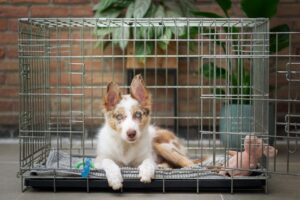Understanding and Managing Separation Anxiety in Dogs: Causes, Symptoms, and Effective Solutions
This article provides an overview of the causes, symptoms, identification, prevention, treatment, and long-term care for dogs with separation anxiety.
Understanding Separation Anxiety in Dogs
Separation anxiety in dogs can be a distressing experience for both the pet and their human companions. This condition is not uncommon and can be triggered by various factors, such as changes in routine, suffering a traumatic event, or being away from their most bonded human or animal companion. Learn more about separation anxiety in dogs. For example, a dog who has grown accustomed to constant human interaction may experience separation anxiety when their owner returns to work after an extended period of being home every day.
When a dog experiences separation anxiety, they may exhibit a range of distress behaviors, including trembling, excessive salivation, destructive chewing, and vocalization. For instance, a dog suffering from separation anxiety may excessively vocalize, pace, and even exhibit destructive behaviors such as chewing furniture or scratching doors when left alone. Understanding these symptoms is crucial for identifying and addressing separation anxiety in dogs effectively.
In addition to the common symptoms mentioned, dogs with separation anxiety can also display signs of overgrooming and distress urination or defecation. For example, a dog may excessively lick or chew their fur as a coping mechanism when they are separated from their owner for an extended period. Furthermore, they may exhibit signs of distress such as urinating or defecating in the house, even if they are normally house-trained. These symptoms can significantly impact the well-being of the dog and should be taken seriously to provide appropriate support and treatment [1].
Identifying Separation Anxiety
Identifying separation anxiety in dogs requires a careful observation of their behavior when left alone. Dogs with separation anxiety may exhibit a range of distress behaviors, including urinating and defecating in the house, excessive barking and howling, destructive chewing, digging, attempting to escape from confined spaces, and pacing restlessly. For instance, a dog with separation anxiety may excessively salivate, pant, or engage in frantic attempts to escape when left alone, which are indicative of the distress they experience during separation [1].
Moreover, it’s crucial to rule out other potential behavior issues before diagnosing separation anxiety. For example, submissive or excitement urination, incomplete house training, urine marking, juvenile destruction, and excessive barking due to boredom should be carefully considered and ruled out through behavioral analysis and, if necessary, consultation with a professional dog behaviorist. This comprehensive approach ensures an accurate diagnosis and helps in tailoring an effective treatment plan that specifically addresses the underlying cause of the dog’s distress when left alone.
 Preventing Separation Anxiety in Dogs
Preventing Separation Anxiety in Dogs
Preventing separation anxiety in dogs starts with proper socialization and training. Puppies should be gradually exposed to different people, environments, and experiences to help them become well-adjusted adult dogs. This can include positive interactions with other animals, exposure to various sounds, and meeting new people. Early socialization can help puppies feel more secure and less anxious when faced with new situations as they grow older.
In addition to socialization, it’s essential to establish a routine that includes scheduled alone time for puppies. Providing them with toys and activities to keep them occupied during these periods can promote independence and prevent separation anxiety from developing. Interactive toys and puzzle feeders can be particularly beneficial, as they engage the dog’s mind and provide mental stimulation, reducing the likelihood of boredom and anxiety.
Furthermore, physical exercise plays a crucial role in preventing separation anxiety. Regular walks, playtime, and interactive games not only help dogs release excess energy but also contribute to their overall well-being. By ensuring that dogs receive adequate physical and mental stimulation, owners can help alleviate anxiety and reduce the risk of separation anxiety developing in their canine companions [1]. For example, taking a dog for a daily walk in the park, engaging in interactive play sessions, and providing puzzle toys can all contribute to a well-rounded exercise routine that promotes mental and physical health.
Treating Separation Anxiety in Dogs
When it comes to treating separation anxiety in dogs, there are various methods that can be employed to help alleviate the distress experienced by the affected pets. One effective treatment approach is counterconditioning, which involves creating positive associations with being alone. For instance, associating the time of separation with a special treat or a favorite toy can help the dog feel more at ease when left alone. This method aims to replace the negative emotions linked to separation with positive ones, ultimately reducing the anxiety experienced by the dog [1].
In more severe cases of separation anxiety, a desensitization and counterconditioning program can be implemented. This involves gradually exposing the dog to periods of alone time, starting with short separations and then slowly increasing the duration over time. This gradual exposure helps the dog build up tolerance to being alone and reduces the anxiety triggered by separation from their owner or caregiver. Additionally, medications may be recommended by a veterinarian or veterinary behaviorist, especially for severe cases of separation anxiety. These medications can help alleviate the underlying anxiety and provide the dog with the support needed to cope with their distress [2].
For example, if a dog displays severe distress behaviors such as destructive chewing and excessive vocalization when left alone, a veterinarian may prescribe anti-anxiety medication to help manage the symptoms and support the dog’s overall well-being. However, it’s crucial that any medication intervention is conducted under professional guidance to ensure the safety and health of the dog [2].
 Support and Long-Term Care for Dogs with Separation Anxiety
Support and Long-Term Care for Dogs with Separation Anxiety
Support and long-term care are crucial for dogs with separation anxiety. Retraining is a key component in helping dogs gain independence and adjust to being alone. This can involve gradually increasing the time spent apart from their owners, starting with short separations and then slowly extending the duration over time. For example, if a dog becomes anxious when left alone for even a few minutes, the owner can work on short separations, initially leaving the dog alone for just a minute or two and gradually increasing the time as the dog becomes more comfortable. This process helps the dog build confidence and reduces their distress when separated from their owners.
In addition to retraining, establishing a predictable routine is essential for providing stability and reducing anxiety in dogs with separation anxiety. Dogs thrive on routine, so having a consistent schedule for feeding, exercise, playtime, and alone time can help alleviate their anxiety. Environmental enrichment is also beneficial and can include providing interactive toys, puzzle feeders, and engaging activities to keep the dog mentally stimulated and occupied during periods of separation. These strategies can help prevent boredom and reduce anxiety, contributing to the long-term well-being of a dog with separation anxiety.
Lastly, rehoming options should be carefully considered if a dog’s home environment or lifestyle is not conducive to managing their separation anxiety. While rehoming is a difficult decision, it may be the best option for a dog if their current living situation is perpetuating or exacerbating their anxiety. This decision should be made with the dog’s best interests in mind, ensuring that they can thrive in an environment that supports their emotional and behavioral needs.


 Book Appointment
Book Appointment